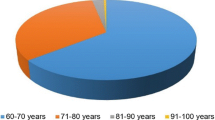Abstract
Purpose
This study describes the outcomes of a modified Manchester procedure on the quality of life and sexual functioning of women with elongation of the uterine cervix with or without pelvic organ prolapse (POP).
Methods
Data on medical and demographic variables were collected from medical files and then women were invited to for follow-up examination and data collection.
Results
Follow-up data were collected from 53 out of 87 women who underwent reconstructive surgery with modified Manchester procedure (60.9% of the women). Prior the surgery, all women in this sample (n = 53) were medically examined and found to have uterine cervix elongation, 40/53 (75.4%) women also had cystocele, 10/53 women (18.8%) had uterine prolapse and 8/53 women (15.1%) had rectocele (all stages II–IV). On follow-up examination, all the cervical stumps were satisfactorily situated, recurrent cystocele was found among 12/53 women (22.6%) women; 13/53 (24.5%) had rectocele; and none of these women had uterine prolapse. Women with POP (cystocele and rectocele) (24/53) had less operative satisfaction (p = 0.004), lower quality of life (p < 0.05 in 3 out of 8 domains), and poorer sexual function (p = 0.03) compared to women without POP (29/53).
Conclusion
The modified Manchester procedure including reconstructive surgery for women with cervix elongation, with or without POP, prevented recurrent uterine prolapse and was well received in terms of patient’s satisfaction, quality of life, and sexual function.
Similar content being viewed by others
References
DeLancey J, Richardson A (1992) Anatomy of genial support. In: Benson J (ed) Female pelvic floor disorders. Norton Medical Books, New York
Maher C, Feiner B, Baessler K, Adams EJ, Hagen S, Glazener CM (2010) Surgical management of pelvic organ prolapse in women. Cochrane Database Syst Rev: CD004014
Hagen S, Stark D, Maher C, Adams E (2008) Conservative management of pelvic organ prolapse in women. Cochrane Database Syst Rev: CD003882
Olsen AL, Smith VJ, Bergstrom JO, Colling JC, Clark AL (1997) Epidemiology of surgically managed pelvic organ prolapse and urinary incontinence. Obstet Gynecol 89:501–506
DeLancey JO (2005) The hidden epidemic of pelvic floor dysfunction: achievable goals for improved prevention and treatment. Am J Obstet Gynecol 192:1488–1495
Lawrence JM, Lukacz ES, Nager CW, Hsu JW, Luber KM (2008) Prevalence and co-occurrence of pelvic floor disorders in community-dwelling women. Obstet Gynecol 111:678–685
MacLennan AH, Taylor A, David H (2000) The prevalence of pelvic floor disorders and their relationship to gender, age, parity and mode of delivery. Int J Obstet Gynaecol 107:1460–1470
Digesu GA, Khullar V, Cardozo L, Robinson D, Salvatore S (2005) P-QOL: a validated questionnaire to assess the symptoms and quality of life of women with urogenital prolapse. Int Urogynecol J Pelvic Floor Dysfunct 16:176–81 (discussion 81)
Liebergall-Wischnitzer M, Hochner-Celnikier D, Lavy Y, Manor O, Shveiky D, Paltiel O (2009) Randomized trial of circular muscle versus pelvic floor training for stress urinary incontinence in women. J Womens Health (Larchmt) 18:377–385
Rogers GR, Villarreal A, Kammerer-Doak D, Qualls C (2001) Sexual function in women with and without urinary incontinence and/or pelvic organ prolapse. Int Urogynecol J Pelvic Floor Dysfunct 12:361–365
Jelovsek JE, Maher C, Barber MD (2007) Pelvic organ prolapse. Lancet 369:1027–1038
Diwan A, Rardin CR, Kohli N (2004) Uterine preservation during surgery for uterovaginal prolapse: a review. Int Urogynecol J Pelvic Floor Dysfunct 15:286–292
Zucchi A, Lazzeri M, Porena M, Mearini L, Costantini E (2010) Uterus preservation in pelvic organ prolapse surgery. Nat Rev Urol 7:626–633
Petros P (2000) Influence of hysterectomy on pelvic-floor dysfunction. Lancet 356:1275
de Boer TA, Milani AL, Kluivers KB, Withagen MI, Vierhout ME (2009) The effectiveness of surgical correction of uterine prolapse: cervical amputation with uterosacral ligament plication (modified Manchester) versus vaginal hysterectomy with high uterosacral ligament plication. Int Urogynecol J Pelvic Floor Dysfunct 20:1313–1319
Thys SD, Coolen AL, Martens IR et al (2011) A comparison of long-term outcome between Manchester Fothergill and vaginal hysterectomy as treatment for uterine descent. Int Urogynecol J Pelvic Floor Dysfunct 22(9):1171–1178
Costantini E, Mearini L, Bini V, Zucchi A, Mearini E, Porena M (2005) Uterus preservation in surgical correction of urogenital prolapse. Eur Urol 48:642–649
Hefni M, El-Toukhy T, Bhaumik J, Katsimanis E (2003) Sacrospinous cervicocolpopexy with uterine conservation for uterovaginal prolapse in elderly women: an evolving concept. Am J Obstet Gynecol 188:645–650
Ayhan A, Esin S, Guven S, Salman C, Ozyuncu O (2006) The Manchester operation for uterine prolapse. Int J Gynaecol Obstet 92:228–233
Baden WF, Walker TA, Lindsey JH (1968) The vaginal profile. Tex Med 64:56–58
Haylen BT, de Ridder D, Freeman RM et al (2010) An International Urogynecological Association (IUGA)/International Continence Society (ICS) joint report on the terminology for female pelvic floor dysfunction. Neurourol Urodyn 29:4–20
Ozel B, White T, Urwitz-Lane R, Minaglia S (2006) The impact of pelvic organ prolapse on sexual function in women with urinary incontinence. Int Urogynecol J Pelvic Floor Dysfunct 17:14–17
de Oliveira MS, Tamanini JT, de Aguiar Cavalcanti G (2009) Validation of the Prolapse Quality-of-Life Questionnaire (P-QoL) in Portuguese version in Brazilian women. Int Urogynecol J Pelvic Floor Dysfunct 20:1191–1202
Svihrova V, Digesu GA, Svihra J, Hudeckova H, Kliment J, Swift S (2010) Validation of the Slovakian version of the P-QOL questionnaire. Int Urogynecol J Pelvic Floor Dysfunct 21:53–61
Fenton KA, Johnson AM, McManus S, Erens B (2001) Measuring sexual behaviour: methodological challenges in survey research. Sex Transm Infect 77:84–92
Conflict of interest
None.
Author information
Authors and Affiliations
Corresponding author
Rights and permissions
About this article
Cite this article
Liebergall-Wischnitzer, M., Ben-Meir, A., Sarid, O. et al. Women’s well-being after Manchester procedure for pelvic reconstruction with uterine preservation: a follow-up study. Arch Gynecol Obstet 285, 1587–1592 (2012). https://doi.org/10.1007/s00404-011-2195-0
Received:
Accepted:
Published:
Issue Date:
DOI: https://doi.org/10.1007/s00404-011-2195-0




